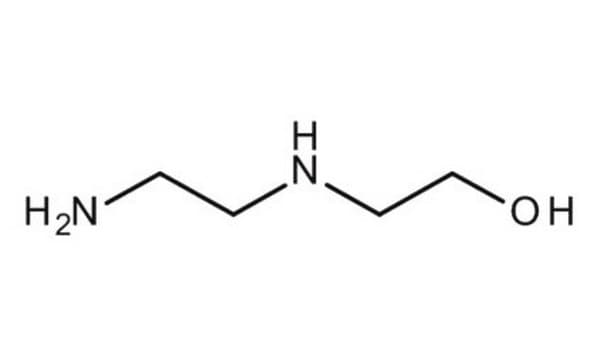09293
2-(3-Aminopropylamino)ethanol
≥98.0% (GC)
Sinónimos:
N-(2-Hydroxyethyl)trimethylenediamine
About This Item
Productos recomendados
Nivel de calidad
Ensayo
≥98.0% (GC)
índice de refracción
n20/D 1.486
bp
250-252 °C (lit.)
densidad
1.007 g/mL at 20 °C (lit.)
cadena SMILES
NCCCNCCO
InChI
1S/C5H14N2O/c6-2-1-3-7-4-5-8/h7-8H,1-6H2
Clave InChI
GHKSKVKCKMGRDU-UHFFFAOYSA-N
Información sobre el gen
rat ... Grin2a(24409)
Otras notas
Palabra de señalización
Danger
Frases de peligro
Consejos de prudencia
Clasificaciones de peligro
Eye Dam. 1 - Skin Corr. 1B - Skin Sens. 1
Código de clase de almacenamiento
8A - Combustible corrosive hazardous materials
Clase de riesgo para el agua (WGK)
WGK 3
Punto de inflamabilidad (°F)
296.6 °F
Punto de inflamabilidad (°C)
147 °C
Equipo de protección personal
Faceshields, Gloves, Goggles, type ABEK (EN14387) respirator filter
Elija entre una de las versiones más recientes:
Certificados de análisis (COA)
It looks like we've run into a problem, but you can still download Certificates of Analysis from our Documentos section.
Si necesita más asistencia, póngase en contacto con Atención al cliente
¿Ya tiene este producto?
Encuentre la documentación para los productos que ha comprado recientemente en la Biblioteca de documentos.
Los clientes también vieron
Active Filters
Nuestro equipo de científicos tiene experiencia en todas las áreas de investigación: Ciencias de la vida, Ciencia de los materiales, Síntesis química, Cromatografía, Analítica y muchas otras.
Póngase en contacto con el Servicio técnico











